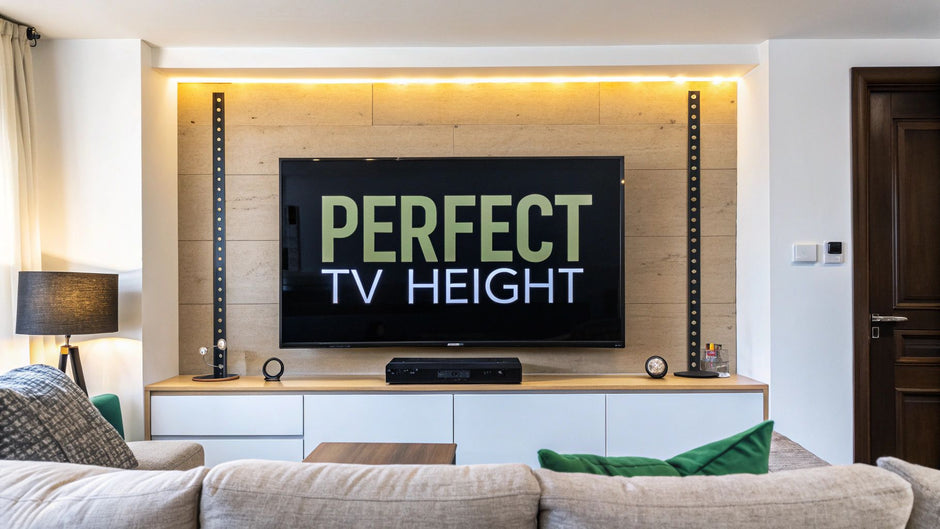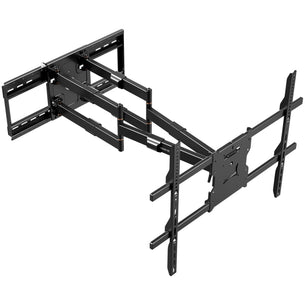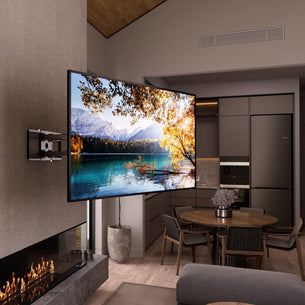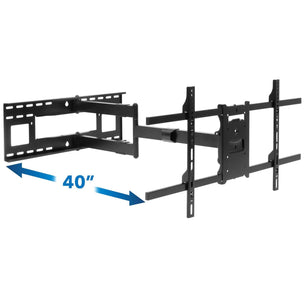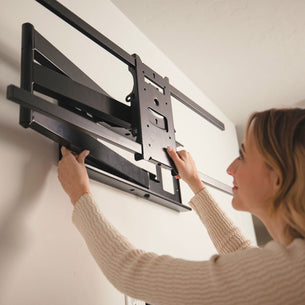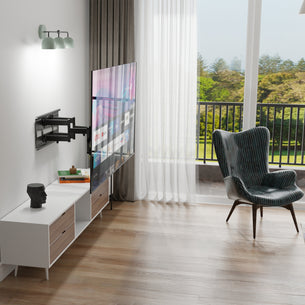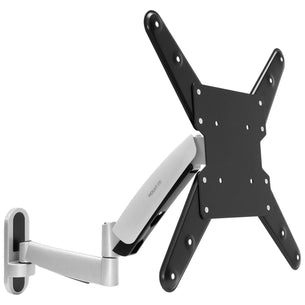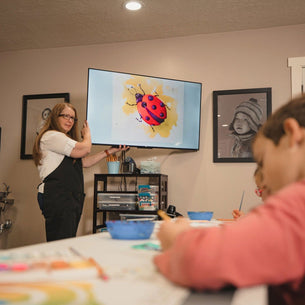Understanding TV Mounting Height And Viewing Ergonomics
Finding the best height for your TV wall mount isn't just about aesthetics; it's about creating a comfortable and immersive viewing experience. Ergonomics, the science of designing spaces to fit the people who use them, plays a crucial role. Incorrect TV placement can lead to neck strain, eye fatigue, and a less enjoyable viewing experience. Understanding how your body interacts with your viewing setup is key.
Eye Level and Viewing Angle: The Dynamic Duo
The core principle of ergonomic TV placement revolves around eye level. Ideally, the center of your TV screen should align with your eyes when you're seated in your primary viewing position. This minimizes strain by keeping your head in a natural, relaxed position. It's similar to reading a book: holding it too high or too low for extended periods becomes uncomfortable.
Viewing angle, the angle at which you're looking at the screen, also matters. Too high, and you're tilting your head back; too low, you're craning your neck down. Both can lead to discomfort. You might be interested in: Why is Ergonomics Important Anyways?
The 40-42 Inch Benchmark
While personal preferences vary, a general rule of thumb suggests the screen's center should be around 40 to 42 inches from the floor. This generally aligns with average seated eye level, promoting comfort and reducing neck strain. Learn more about optimal TV mounting height. However, factors like your seating height, TV size, and room layout all contribute.
Room Layout and Seating Arrangements: Personalizing Your Setup
The best height also depends on your room and how you use it. Consider your seating: is it a formal living room with a standard sofa, or a casual space with beanbags or recliners? Furniture height and the distance between seating and the wall impact optimal TV height.
For instance, a higher sofa might require a slightly higher TV placement, while a lower chair might necessitate a lower position. A larger room with a greater viewing distance might call for a slightly higher mount to maintain a comfortable viewing angle. Finding the perfect height involves experimentation and fine-tuning.
Perfect Heights For Every TV Size And Screen Type
Different TV sizes and screen technologies call for different mounting approaches. An incorrect height can significantly impact your viewing experience. This guide breaks down the ideal measurements for common TV sizes, ranging from smaller 32-inch models to large 75-inch screens.
Finding The Sweet Spot: Balancing Size And Height
The perfect viewing experience depends on the relationship between screen size and mounting height. A larger screen needs a slightly higher mount to maintain a comfortable viewing angle. Imagine a movie theater: the larger the screen, the further back and higher the projector.
For instance, a 55-inch TV might be perfect with the center of the screen at about 42 inches from the floor, matching average seated eye level. A 75-inch screen, however, might benefit from a higher mount, perhaps around 45-48 inches, to fit the entire display within a comfortable viewing range.
Screen Technology And Viewing Angles: OLED, QLED, and LED
Screen technology also influences ideal height. OLED and QLED displays typically offer wider viewing angles than standard LED TVs. This allows for more flexibility in mounting height, potentially allowing a slightly higher position without compromising picture quality. Even with these wider angles, eye-level viewing remains key for comfort.
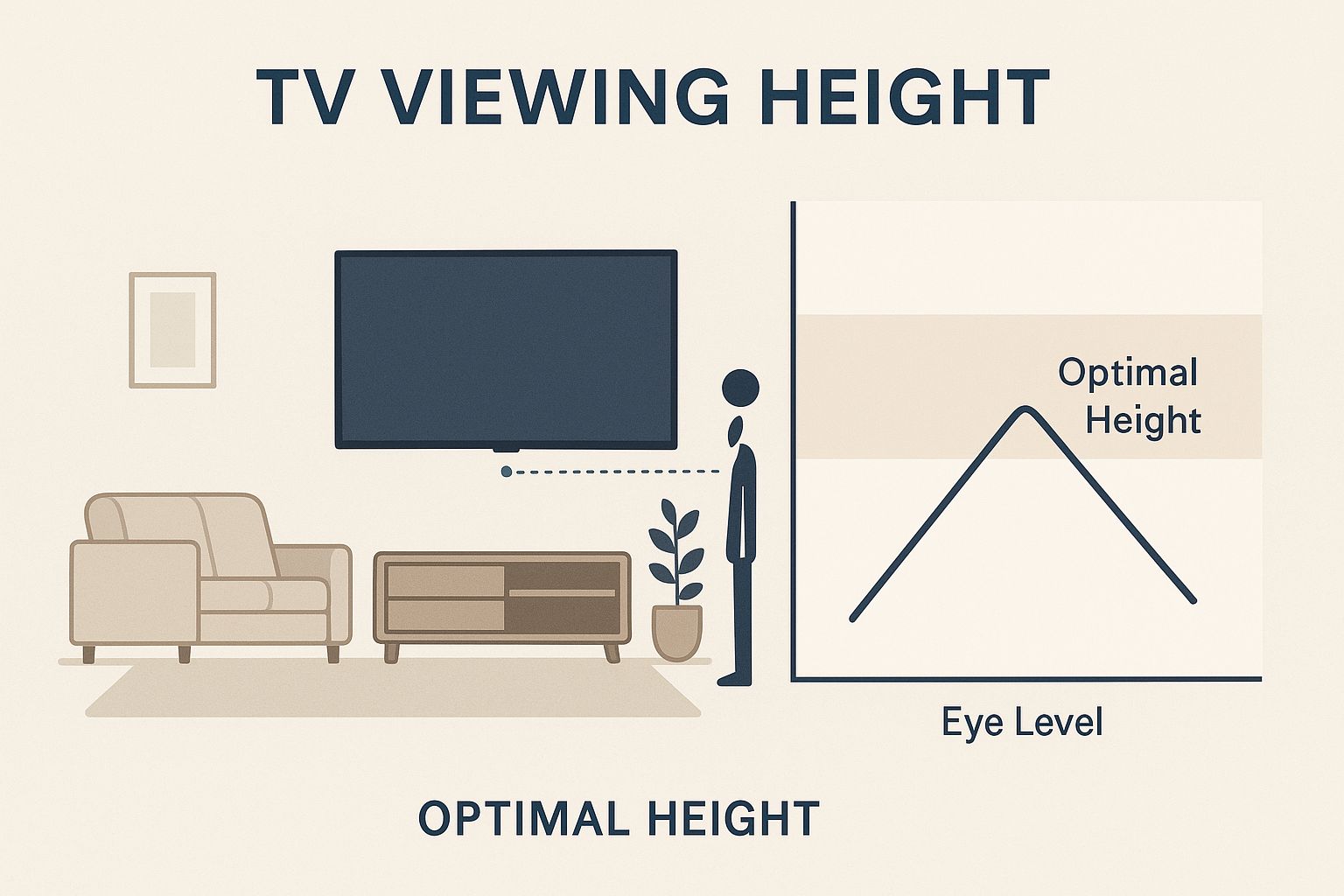
This infographic shows a living room with a TV mounted at the optimal height, highlighting the importance of eye-level placement for comfortable viewing. Positioning the center of the screen at eye level minimizes neck strain and creates a more enjoyable experience. Read also: How High Should I Mount My TV?
Calculating Exact Center Points: A Step-by-Step Guide
Accurate measurements are essential for optimal TV placement. Start by measuring your seated eye level. Then, find the height of your TV and divide it by two to locate its center point. Subtract half the TV's height from your eye level measurement. This determines the ideal height for the bottom edge of your TV from the floor. As an example, if your eye level is 42 inches and your 65-inch TV is 32 inches tall, the bottom of your TV should be about 26 inches from the floor (42 - 16 = 26).
Accounting for Bezels and Mounting Hardware: Fine-Tuning Your Calculations
Don't forget to factor in the thickness of your TV's bezel (the frame around the screen) and the mounting hardware. These can add a few extra inches to the overall height. You might need to adjust your calculations slightly to ensure the visible screen area aligns perfectly with your eye level. This fine-tuning guarantees the best possible viewing experience.
To further assist you, here's a handy reference guide:
TV Size To Mounting Height Reference Guide
This table provides a comprehensive breakdown of recommended mounting heights based on TV screen size and viewing distance.
| TV Size | Center Height From Floor | Recommended Viewing Distance | Mount Position Range |
|---|---|---|---|
| 32" | 40" | 4-6 ft | 38-42" |
| 43" | 42" | 5-7 ft | 40-44" |
| 55" | 42-45" | 6-9 ft | 40-47" |
| 65" | 45-48" | 7-11 ft | 43-50" |
| 75" | 48-51" | 9-14 ft | 46-53" |
This table offers a general guideline. Individual preferences and room setups may require slight adjustments. Consider these recommendations as a starting point and adjust accordingly for optimal viewing comfort.
How TV Mounting Practices Have Transformed Over Time
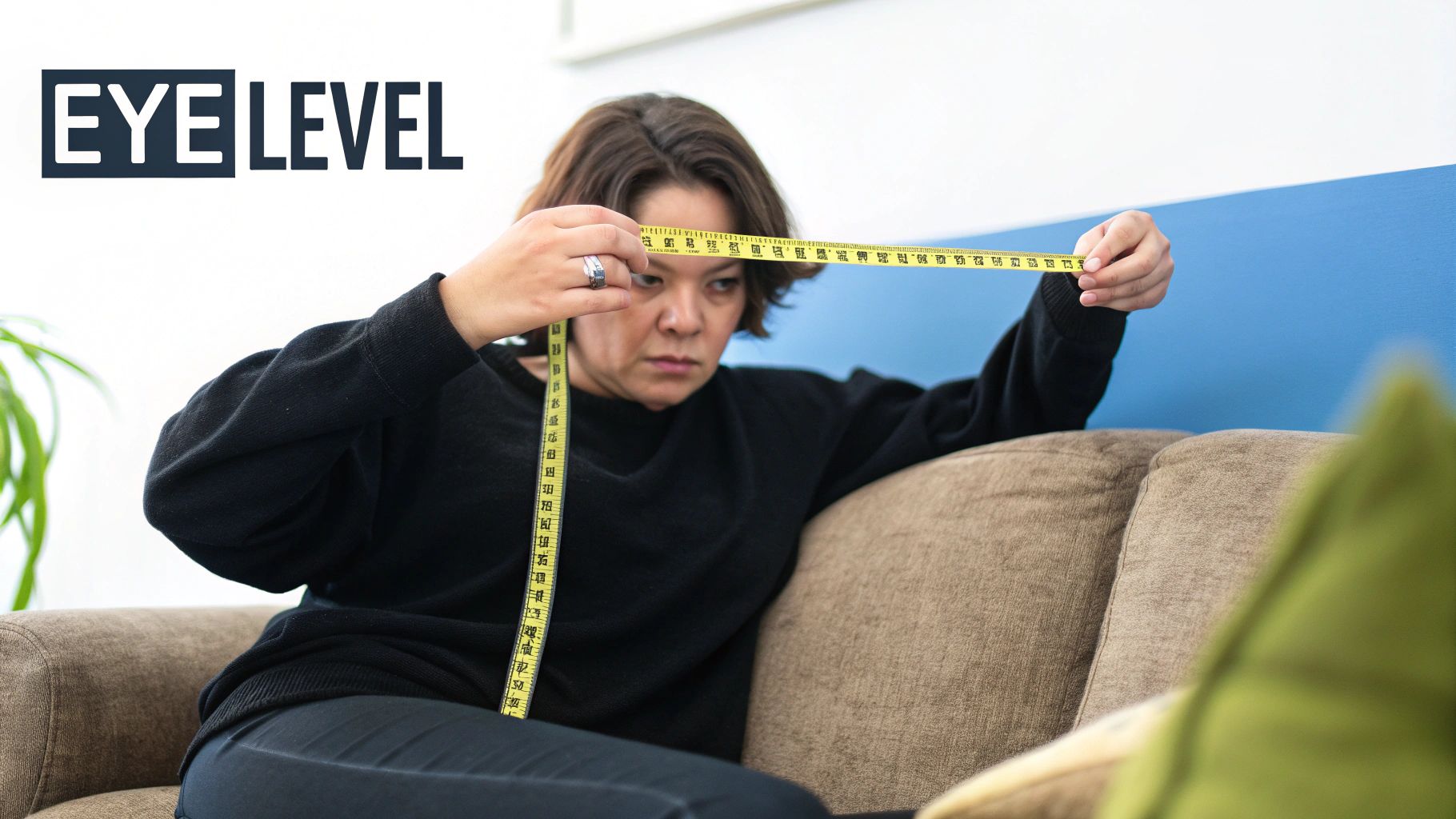
TV mounting wasn't always about sleek designs and comfortable viewing. The journey of TV mounting reflects the changes in televisions themselves. Early CRT televisions, bulky and heavy, often sat on large entertainment centers. When wall-mounted, these sets were typically placed high to accommodate the furniture below and the TV's depth.
This high placement wasn't ideal for long viewing sessions. This practice was due to both technology and interior design trends. CRT televisions generated significant heat, requiring good ventilation, often achieved through higher placement. The design of entertainment centers also often dictated the TV's position. This often led to viewers craning their necks upwards, causing discomfort. You might find this interesting: TV Wall Mount or Stand: An In-Depth Comparison
The Flat-Screen Revolution: A Shift in TV Placement
The arrival of flat-screen technology, starting with plasma and then LCD and LED screens, changed TV mounting. These slimmer, lighter displays offered new placement options. Mounting at eye level became possible, prioritizing comfort and ergonomics. This change matched evolving viewing habits as screen sizes increased and home theaters became more popular.
Historically, guidelines for TV mounting height have changed, reflecting shifts in technology and viewing habits. In the early 2000s, TVs were often mounted higher, frequently above fireplaces. As of 2023, experts suggest mounting TVs at eye level when seated, generally around 40 to 50 inches from the floor. Learn more about ideal TV height.
Modern Mounting: Balancing Aesthetics and Function
Today, the ideal TV mounting height balances aesthetics and ergonomics. While eye level is the main guide, factors like room layout, seating, and screen size influence the final decision. Modern mounts offer various options, from fixed mounts for optimal angles to full-motion mounts for viewing flexibility.
This lets viewers customize their setup, achieving both a visually appealing look and a comfortable viewing experience.
Solving Challenging Room Layouts and Special Situations
Real homes rarely have perfect dimensions. Fireplaces, tall furniture, and awkward wall spaces can make finding the ideal TV height a challenge. Standard guidelines might not always work. This section offers practical solutions for these tricky situations, ensuring a comfortable viewing experience even in unconventional setups.
Mounting Above a Fireplace: Balancing Aesthetics and Ergonomics
Mounting above a fireplace is popular, but it often places the TV too high, causing neck strain. If this is your preferred setup, consider a tilting mount. This lets you angle the screen down for a more natural viewing angle. Also, consider your fireplace's heat output. Too much heat can damage electronics. Ensure proper ventilation and consider a heat shield if necessary.
Bedrooms and Lofts: Accommodating Unique Viewing Positions
Bedrooms often have tall beds and angled viewing positions. The ideal TV height might be higher than the standard 42 inches. Consider your usual viewing position from bed. Mark your sightline on the wall, aiming to position the screen's center around that point. A tilting mount is helpful here, minimizing glare and optimizing viewing comfort. Check out our guide on How to Mount a TV in a Corner for ideas on using unusual spaces.
Corner Placements: Maximizing Space and Viewing Angles
Corners present unique challenges. An angled mount, designed for corners, can optimize viewing angles and maximize space. These mounts often swivel and tilt, providing flexibility for different seating arrangements. This is especially useful in smaller rooms where furniture placement is limited. Just as TV mounting has changed, so has home security. See this article on the Evolution of Integrated Security Systems: From Simple Alarms to Smart Homes for a fascinating comparison.
Multi-Purpose Rooms and Mixed Seating: Finding the Compromise Position
In rooms with varied seating heights – like a combined living/dining area – one “perfect” height may not exist. Prioritize the primary viewing area. Consider an adjustable mount to reposition the TV for different activities. This allows flexibility for movie nights, casual viewing, or even presentations.
Awkward Walls and Obstructions: Working Around Limitations
Sometimes, structural elements like windows or beams dictate mounting options. Think creatively. A smaller TV might suit a confined space. Alternatively, consider projecting onto a screen. Work with your space's limitations while prioritizing comfortable viewing.
By understanding these special situations and using creative solutions, you can find the best TV height for any room, regardless of layout or challenges. Prioritize viewing comfort and adapt the usual rules as needed to create an enjoyable and ergonomic entertainment experience.
Professional Installation Secrets And Costly Mistakes
Essential Preparation: The Foundation of a Successful Mount
Before you even pick up a drill, proper preparation is key. This includes accurately locating studs in your wall. Studs provide the crucial support your TV needs, especially for larger, heavier models. Use a reliable stud finder to ensure you're mounting into solid support and not just empty drywall. Mounting into drywall alone can lead to a disastrous outcome – a falling TV!
Also, think about cable management before you start mounting. Planning your cable routes and concealment methods beforehand leads to a cleaner, more professional look. This proactive approach saves you time and headaches later on.
Proper Tool Selection: Working Smarter, Not Harder
Having the right tools makes a world of difference. Invest in a quality drill with the appropriate drill bits for your wall type. A level is absolutely essential for a straight mount and a perfectly positioned TV.
Using the correct tools not only simplifies the process but also minimizes the risk of errors. This contributes to a more polished and satisfying final result.
Safety First: Protecting Yourself and Your Equipment
Safety should always be your top priority. Before working with any wiring, turn off the power at the breaker box. Wear safety glasses to protect your eyes from flying debris. And for larger screens, get a friend to help with lifting and positioning the TV to prevent injuries and protect your equipment.
Professional Stud Detection and Level Mounting: The Keys to a Secure Installation
Accurate stud detection is paramount. A misaligned mount can result in a wobbly TV, or worse, a complete dismount. Use your stud finder methodically, marking each stud location clearly and double-checking your findings before drilling. This careful approach guarantees a secure and stable mount, protecting your valuable TV.
Level mounting is equally important. Use a level at various points during installation, checking both horizontally and vertically. This ensures a straight and balanced setup, giving you peace of mind that your TV is securely in place.
Troubleshooting and Recovery: Handling Unexpected Issues
Even the best-laid plans can encounter hiccups. If measurements are slightly off, shims can help adjust the mount and achieve a level position. However, if you run into unexpected obstacles inside the wall, it's best to consult a professional. Knowing when to call in an expert can prevent further damage and ensure a safe and correct installation.
Knowing When to Call a Professional: Avoiding Costly Mistakes
While DIY can be rewarding, some situations call for professional expertise. If you're dealing with complex wiring, unusual wall materials, or an especially large or heavy TV, consider hiring a professional installer. Their experience ensures a safe and correct installation, preventing potentially costly repairs and injuries.
To help you avoid common pitfalls, we've created a handy checklist:
TV Mounting Mistake Prevention Checklist
This table outlines common TV mounting errors, their causes, prevention methods, and the difficulty of fixing them.
| Common Mistake | Why It Happens | Prevention Method | Fix Difficulty |
|---|---|---|---|
| Mounting to drywall only | Failure to locate studs | Use a stud finder diligently | Difficult |
| Uneven mounting | Incorrect leveling | Use a level at multiple points during installation | Moderate |
| Poor cable management | Lack of planning | Map out cable routes before mounting | Easy |
| Incorrect height | Mismeasuring eye level | Double-check measurements and consider viewer comfort | Moderate |
| Damage to wall | Incorrect drill bit size | Use the correct drill bits for your wall type | Difficult |
By following these professional tips and avoiding common mistakes, you can achieve a perfectly mounted TV that is both aesthetically pleasing and secure. A well-planned installation will provide years of enjoyable viewing.
Accommodating Multiple Viewers And Mixed Use Spaces
Finding the perfect TV wall mount height can be tricky, especially when you're trying to please everyone in the house. Balancing the needs of adults, children, and the various ways you use your space requires thoughtful planning and adaptable solutions. Let's explore some strategies to create viewing harmony in diverse environments.
Families With Children: Finding a Happy Medium
Kids and adults see the world from different heights – literally. A fixed TV positioned perfectly for grown-ups might be a pain in the neck for younger viewers. A good compromise is mounting the TV slightly lower than the ideal adult height. Alternatively, consider adjustable mounts. These allow you to lower the TV for children's programs and raise it back up for adult viewing.
Mixed-Use Spaces: The Versatility of Articulating Mounts
When a room has to pull double duty, like a home office that transforms into a media room, flexibility is key. An articulating arm mount is your best friend here. Position the TV for optimal movie nights, then effortlessly swivel and adjust it for presentations or Zoom meetings. This adaptability ensures comfortable viewing no matter the activity. And if you're going the DIY route, accurate measurements are essential. A good expert installation guide, even one for window treatments, can offer helpful tips on precise measuring techniques.
Accessibility for Elderly Viewers: Comfort and Safety First
For elderly viewers, comfort and safety are paramount. A lower-than-average TV position, closer to the seating, can improve visibility and reduce neck strain. Supportive seating and good lighting in the viewing area are also crucial for a pleasant and safe viewing experience.
Compromise Positioning: Striking a Balance With Mixed Seating
Rooms with a variety of seating heights, such as couches and bar stools, present a unique challenge. In these situations, focus on the primary seating area. Consider mounting the TV a bit higher than usual to accommodate the elevated view from bar stools or taller chairs. While this might not be perfect for everyone, it creates a comfortable balance for most viewers.
Full-Motion Mounts: The Ultimate in Flexibility
For households with significant height differences or multiple viewing areas, a full-motion mount offers unparalleled adaptability. These mounts allow tilting, swiveling, and extending, catering to various seating heights and preferences. While the initial cost might be higher than fixed mounts, the added versatility often makes them a worthwhile investment for families or shared spaces. Remember, the ideal height is just one piece of the puzzle. A truly successful TV mounting solution considers the unique needs and activities of the space and its occupants.
Testing and Fine-Tuning Your Perfect Setup
After mounting your TV, the crucial final step is testing and fine-tuning. This involves evaluating your installation in real-world viewing conditions, from casual news to immersive movies. This process goes beyond initial impressions and focuses on long-term viewing comfort. Learn more in our article about Optimal TV Height Guide: Transform Your Viewing Experience.
Evaluating Your Installation: Beyond the First Glance
Your initial setup might seem perfect, but subtle issues can emerge during extended viewing. Test with various content and viewing positions. Watch a fast-paced sports game, a dimly lit drama, and a brightly animated cartoon.
Observe how your comfort levels change throughout these different experiences. Pay attention to any eye strain, neck discomfort, or viewing fatigue. These subtle cues indicate potential height adjustments.
Fine-Tuning Adjustments: Achieving Long-Term Comfort
Even minor adjustments can significantly impact long-term comfort. If you experience neck strain, try lowering the TV slightly. If your eyes feel tired, the TV might be too high or too bright for your viewing distance.
Adjusting your TV's brightness and contrast settings can also improve viewing comfort, especially in darker rooms. Consider using tilting mounts to further optimize your viewing angle.
Seasonal Considerations and Long-Term Maintenance
Room temperature and lighting can change with the seasons, influencing your viewing comfort. In brighter summer months, glare might become an issue, requiring a slight adjustment to your TV's angle or position. In winter, a lower TV position might feel more comfortable as you’re cozy under blankets.
Regular dusting and cleaning of your TV screen also contributes to optimal viewing clarity and reduces eye strain.
Measuring Success: Beyond Initial Impressions
Successfully mounting your TV involves more than just a visually appealing setup. True success lies in sustained viewing comfort. Regularly assess your viewing experience and make small adjustments as needed. This proactive approach helps you maintain an enjoyable entertainment space for years to come.

